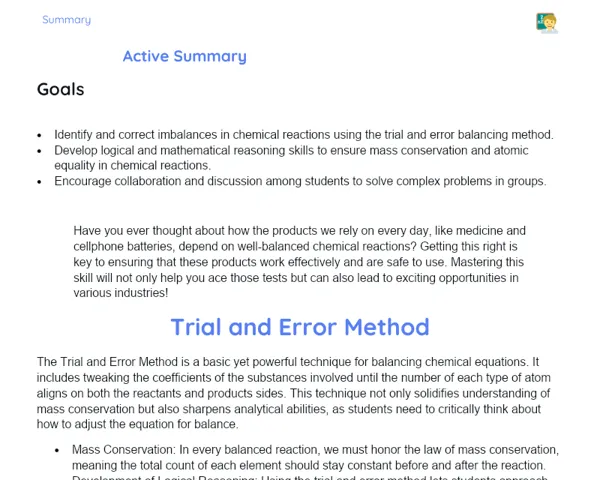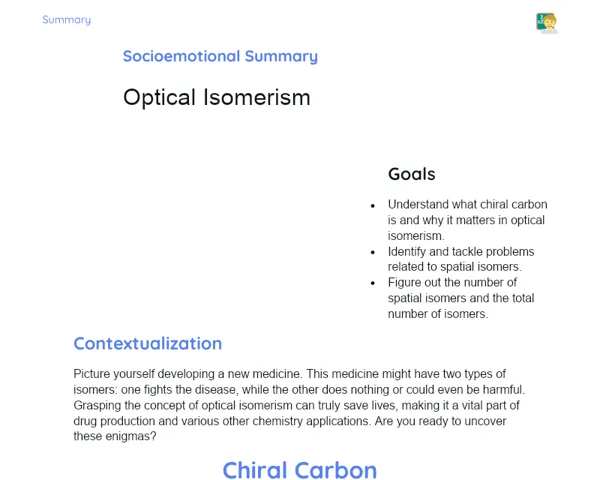Goals
1. Understand what aldehydes are and their structural features.
2. Differentiate aldehydes from ketones based on their chemical structures.
3. Identify the physical and chemical properties of aldehydes.
4. Connect the properties of aldehydes to their applications in the job market.
5. Find examples of aldehydes in everyday life and in various industries.
Contextualization
Aldehydes are organic compounds that you encounter regularly, playing crucial roles across different industries. From the sweet scent of vanilla to their use in manufacturing plastics and resins, aldehydes are key ingredients in many of the products we rely on each day. Grasping their structures and properties is vital for applying them in innovative ways in the job market. For instance, formaldehyde is a simple aldehyde commonly used in making building materials, disinfectants, and personal care items. Likewise, benzaldehyde finds a place in the perfume and food sectors due to its appealing scent.
Subject Relevance
To Remember!
Definition and Structure of Aldehydes
Aldehydes are organic compounds defined by the presence of the formyl functional group (–CHO). This group is always located at the end of the carbon chain, which sets aldehydes apart from other organic compounds, like ketones, where the carbonyl group (C=O) is found within the chain.
-
Aldehydes possess the formyl functional group (–CHO).
-
The formyl group is always at the terminal position in the carbon chain.
-
Aldehydes are distinct from ketones, which have the carbonyl group within the chain.
Differences between Aldehydes and Ketones
Although both aldehydes and ketones contain the carbonyl group (C=O), their placement in the carbon chain is what differentiates the two. In aldehydes, the carbonyl group binds to a hydrogen atom and a carbon chain, whereas in ketones, it connects to two carbon chains.
-
Aldehydes have the carbonyl group attached to a hydrogen atom and a carbon chain.
-
Ketones have the carbonyl group attached to two carbon chains.
-
The position of the carbonyl group impacts the physical and chemical properties of both aldehydes and ketones.
Physical and Chemical Properties of Aldehydes
Aldehydes display specific physical and chemical properties due to the formyl group. They frequently appear as liquids or solids with low melting and boiling points. Chemically, aldehydes are reactive, capable of undergoing oxidation and reduction reactions, as well as participating in nucleophilic addition reactions.
-
Aldehydes typically have low melting and boiling points.
-
They are reactive compounds that can be easily oxidized or reduced.
-
The carbonyl group allows them to engage in nucleophilic addition reactions.
Practical Applications
-
In the perfume industry, benzaldehyde is used to create almond fragrances.
-
Formaldehyde is commonly utilized in manufacturing building materials like resins and plywood.
-
Vanillin, an aldehyde, serves as a flavoring agent particularly in sweet treats in the food industry.
Key Terms
-
Aldehyde: Organic compound including the formyl functional group (–CHO).
-
Ketones: Organic compounds featuring a carbonyl group (C=O) linked to two carbon chains.
-
Formyl Group: The characteristic functional group of aldehydes, consisting of a carbon atom bound to a hydrogen atom and a carbonyl group.
-
Oxidation: A chemical process where a compound loses electrons, often increasing its bonds with oxygen.
-
Reduction: A chemical process where a compound gains electrons, often reducing its bonds with oxygen.
Questions for Reflections
-
How does the chemical structure of aldehydes affect their properties and uses in industry?
-
What safety measures should be taken when working with aldehydes in a laboratory?
-
In what ways can knowledge about aldehydes support the development of new chemical products for the market?
Investigate Aldehydes in Daily Life
This mini-challenge offers students the opportunity to use their knowledge of aldehydes to identify and analyse the presence of these compounds in everyday products.
Instructions
-
Select three products from your home that may contain aldehydes (e.g., perfumes, cleaning products, flavoured foods).
-
Research the chemical makeup of these products and identify any aldehydes present.
-
Discuss the properties of the identified aldehydes and how these properties affect the product's functionality.
-
Prepare a short presentation (3-5 minutes) to share your findings with the class.



